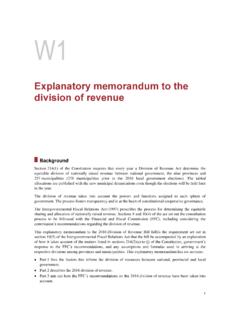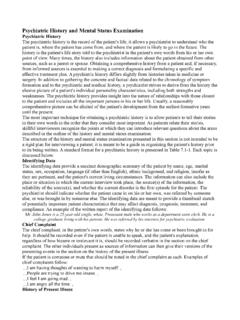Transcription of Published for Student Learning Division
1 Published for Student Learning Division Department of Education and Early Childhood Development Melbourne January 2010 State of Victoria (Department of Education and Early Childhood Development) 2010 The copyright in this document is owned by the State of Victoria (Department of Education and Early Childhood Development), or in the case of some materials, by third parties (third party materials). No part may be reproduced by any process except in accordance with the provisions of the Copyright Act 1968 the National Education Access Licence for Schools (NEALS) (see below) or with permission. NEALS is an educational institution situated in Australia which is not conducted for profit, or a body responsible for administering such an institution may copy and communicate the materials, other than third party materials, for the educational purposes of the institution.
2 Authorised by the Department of Education and Early Childhood Development, ISBN 978-0-7594-0594-3 This document is also available on the internet at Contents 3 Suggested 5 6 Teacher 6 Numeracy 6 7 Planning and 8 Years 1 and 9 Teacher 9 Numeracy 9 10 Planning and 11 Years 3 and 12 Teacher 12 Numeracy 13 14 Planning and 15 Years 5 and 15 Teacher 15 Numeracy 16 17 Planning and 18 19 3 State of Victoria, 2010 Introduction The international evidence-base has reached consensus about the significant influence teachers have in the classroom and the knowledge and the skill base required to teach all students well. In order to improve teacher practice, teachers must not only understand what it looks like to improve in different domains of Learning but they must also believe they are capable of improving their practice.
3 (e5 Instructional Model, DEECD, 2009) They Key Characteristics of Effective Numeracy Teaching P 6 provides a framework to support improvement in teaching and Learning . The purpose of the document is to: Articulate effective practice in numeracy teaching that supports differentiation within the classroom Build knowledge and capacity in numeracy teaching and Learning with a focus on Student improvement Establish a common, shared language to describe effective practice in numeracy teaching The document is applicable to a range of audiences: Classroom teachers: to enable them to guide their planning and instruction, based on Student assessment information; to build discipline and pedagogical content knowledge; to focus discussion in professional Learning teams Principals with the leadership team: to enable substantive conversations to take place with teachers on effective practice in numeracy teaching, to inform Strategic and Annual Implementation Plans including professional Learning opportunities for the whole staff, teams of teachers and individual teachers Regional Network Leaders and other regional staff: to support articulation of clear and consistent messages on numeracy teaching and Learning Students within each class have a wide range of numeracy experiences, abilities and backgrounds.
4 This provides a significant challenge as teachers support all students to develop the knowledge and skills for continuous engagement and improvement in numeracy. International research indicates that teachers need to consider systematically two phases of teaching to respond effectively to the diversity of Student Learning needs and aspirations at all stages of Learning : The first phase quality differentiated classroom teaching for all students, and The second phase additional short-term intervention to accelerate Learning for students not achieving the expected level in numeracy. The Key Characteristics of Effective Numeracy Teaching specifies first phase, quality differentiated classroom teaching for all students. This requires that the teacher proactively plans and carries out varied approaches to content, process, and product in anticipation of and response to Student differences in readiness, interest, and Learning needs (e5 Instructional Model, DEECD, 2009).
5 To plan effectively for differentiated teaching, teachers draw on their knowledge and understanding of key theories and knowledge of the Victorian Essential Learning Standards (VELS) Mathematics standards. This is important for responsive and focused teaching for students at all levels. Teachers also require knowledge of their students, including their interests and prior knowledge, English language proficiency, and identified Learning strengths and areas for improvement. Teachers identify a specific focus for teaching using assessment data. This includes using assessment information to determine purposeful teaching strategies that meet the identified needs of individual students. The use the e5 Instructional Model informs the delivery of the planned curriculum. Teachers assess and monitor students progress, adjusting their instruction to meet the needs of students when appropriate.
6 The Key Characteristics of Effective Numeracy Teaching P-6 is a companion document to the Victorian Literacy and Numeracy Statement and the other three Key Characteristics of Effective Literacy Teaching P-6 and 7-10 and Key Characteristics of Effective Numeracy Teaching 7-10. These documents were informed by research and developed through consultation with classroom practitioners, literacy and numeracy experts, coaches and regional personnel. The document has sections for Prep, Years 1 and 2, Years 3 and 4 and Years 5 and 6, each containing: 4 State of Victoria, 2010 Teacher knowledge disciplinary and pedagogical content knowledge teachers require, at and beyond the level they teach, including VELS Mathematics standards and progression points, Mathematics Developmental Continuum P-10, Early Years Learning and Developmental Framework: Birth to 8 years and information on particular cohorts of students.
7 Numeracy focus advice on essential knowledge and skills on which teachers need to focus. Assessment advice on key assessments and their timing to inform teaching including Mathematics Online Interview, Fractions and Decimals Online Interview: Victorian Curriculum and Assessment Authority (VCAA) On Demand and Progress Tests, Scaffolding Numeracy in the Middle Years, National Assessment Program Literacy and Numeracy (NAPLAN) tests. Planning and instruction This section refers to the e5 Instructional Model which provides a framework to support differentiated, purposeful teaching. It also provides advice on organisational structures and recommended teaching strategies. 5 State of Victoria, 2010 Suggested Readings Mathematics domain page Access information on the Victorian Essential Learning Standards and Mathematics Development Continuum P 10 plus support for numeracy teachers including research, digital Learning resources, assessment maps and sample tasks, web links, professional Learning tools and other numeracy resources.
8 Research eLert Numeracy in practice: teaching, Learning and using mathematics (2009) Report focusing on research and links related to the characteristics of effective numeracy teaching and addressing key classroom issues including: what to teach, how to teach numeracy, how to cater for diversity and how to make best use of technology. Researching Numeracy Teaching Approaches in Primary Schools (2002-2003) Research identifying twelve scaffolding practices that contribute to improved Student Learning outcomes and describing a range of communicative practices that teachers use to support students mathematics Learning . Early Numeracy Research Project (ENRP) A three-year (1999-2001) Prep to Year 2 research project, involving 28 primary schools in developing a comprehensive approach to mathematics. Middle Years Numeracy Research Project (MYNRP) Commissioned to inform the development of a strategic and coordinated approach to the teaching and Learning of numeracy for students in Years 5 9, the final report for this research was Published in 2001.
9 6 State of Victoria, 2010 Prep Teacher knowledge Effective teachers require: thorough knowledge of VELS mathematics domain Learning focus statements and standards and progression points levels 1 and 2 to support planning for differentiated teaching knowledge of the Victorian Early Years Learning and Development Framework: Birth to 8 years knowledge of the Mathematics Developmental Continuum P 10, the indicators of progress, teaching strategies and activities within the Continuum knowledge of key mathematical concepts in levels 1 2 of the Developmental Overviews knowledge of the points of growth in the Mathematics Online Interview knowledge of the particular needs that students may have in relation to English language and numeracy, including students from Koorie, ESL and low SES backgrounds. Numeracy focus Effective teachers determine the numeracy focus by referencing the VELS mathematics standards and progression points.
10 For students achieving at the expected level, effective teachers: teach the counting of numbers (from 1 10, 1 20) moving from rote counting to one-to-one correspondence and making links between counting numbers (cardinal numbers) and placing objects in order (ordinal numbers) engage students in identifying and creating different representations of numbers (1 10, 1 20), recognising the concept of zero as a place holder teach students to read and write numbers and to count, sort, order and label so they can identify when two sets are equal in size and one set is larger than another and to recognise that counting a collection (0 20) again will always produce the same result no matter how the numbers in the collection are changed or manipulated (trusting the count/conservation of number) engage students in developing concepts about number without having to make or count the numbers (subitising) and in exploring patterns in numbers and space by manipulating objects according to simple rules engage students in grouping together and moving apart given numbers, moving to addition and subtraction of the numbers 0 20 and teach ways of recording computations and use simple functions on a calculator engage students in identifying and representing points, lines and curves, 2-D and 3-D shapes, including interior and exterior views, moving from recognising and visualising to comparing, sorting and matching shapes teach students to describe the features, location and orientation of shapes and objects teach the vocabulary and conventions when comparing measurements and engage students in tasks using informal units to measure the length, area, capacity and mass of familiar objects, and tasks to establish awareness of time such as the cycle of days in the week.









